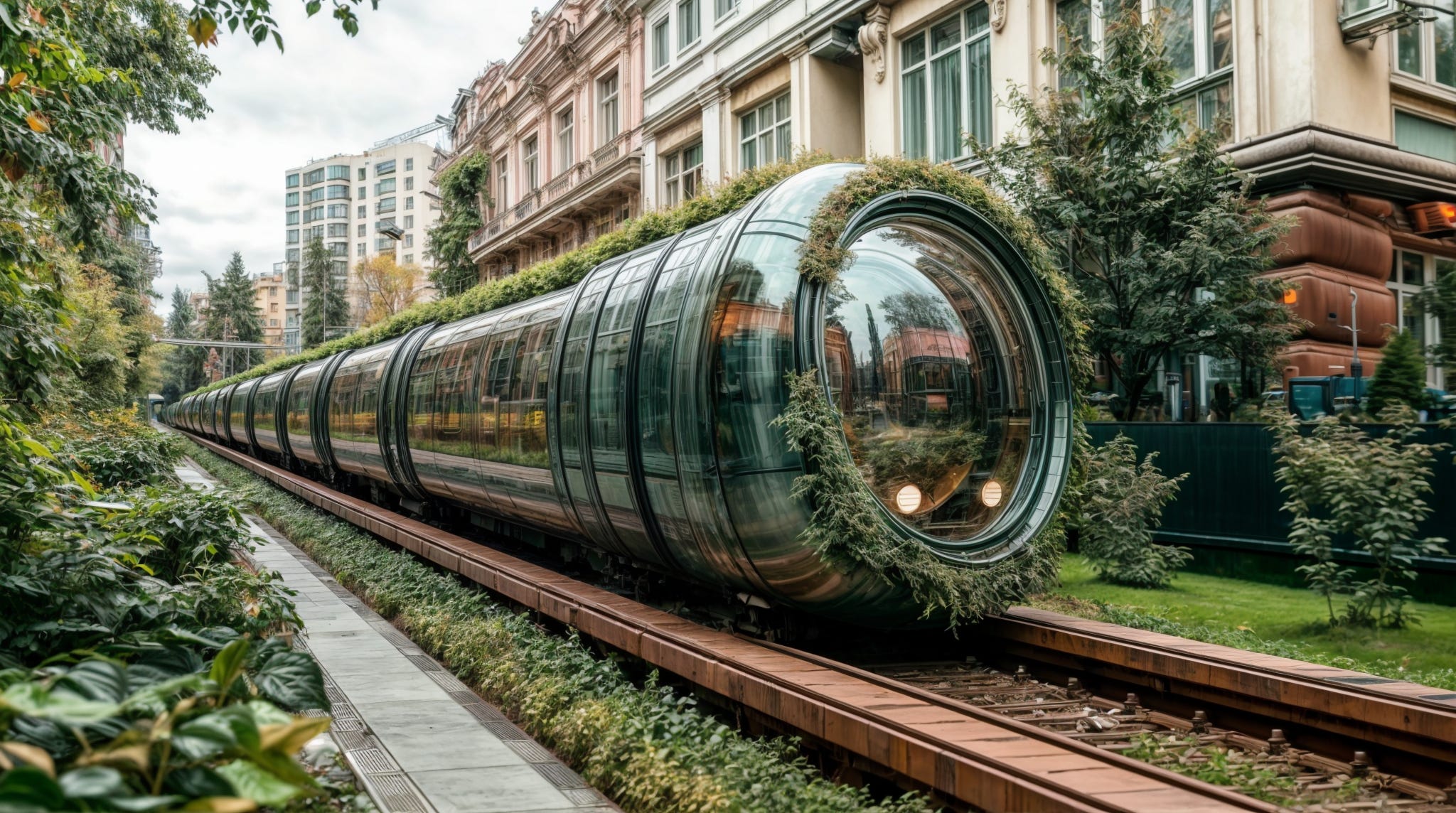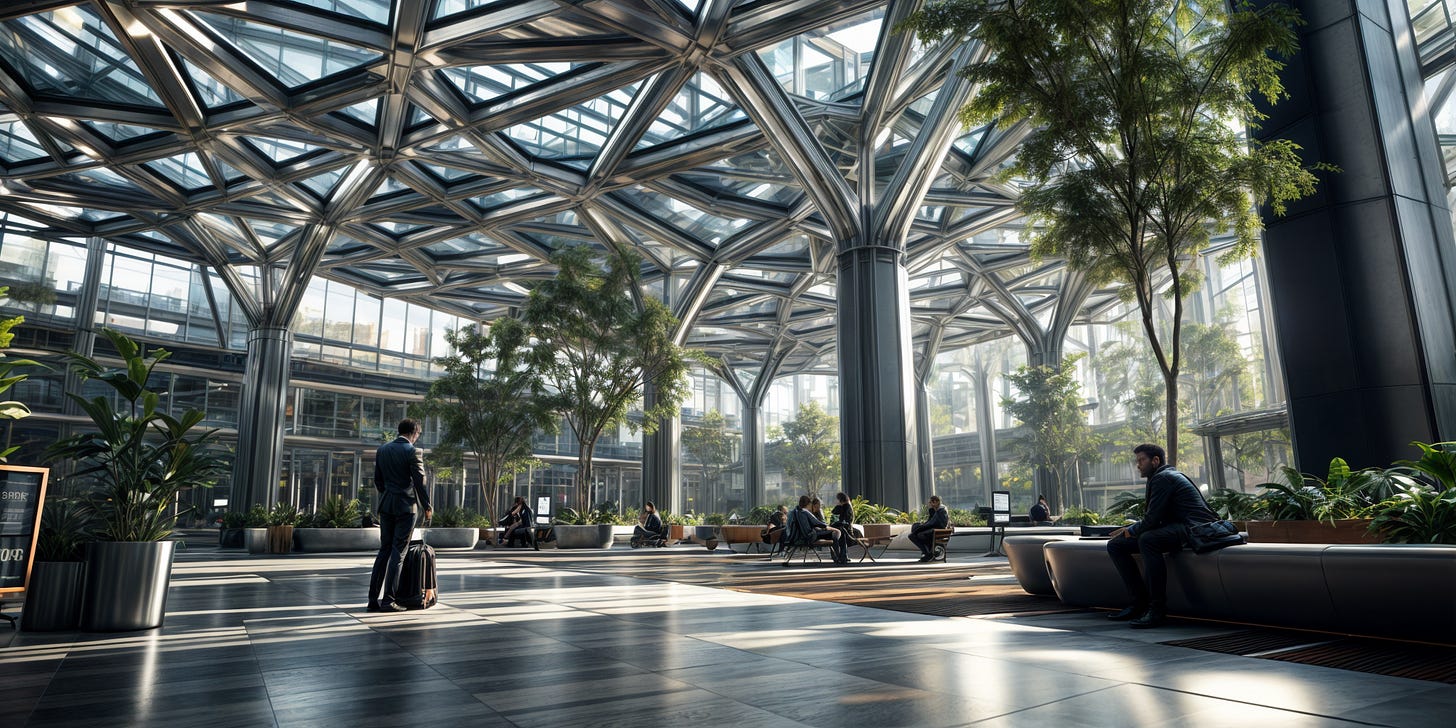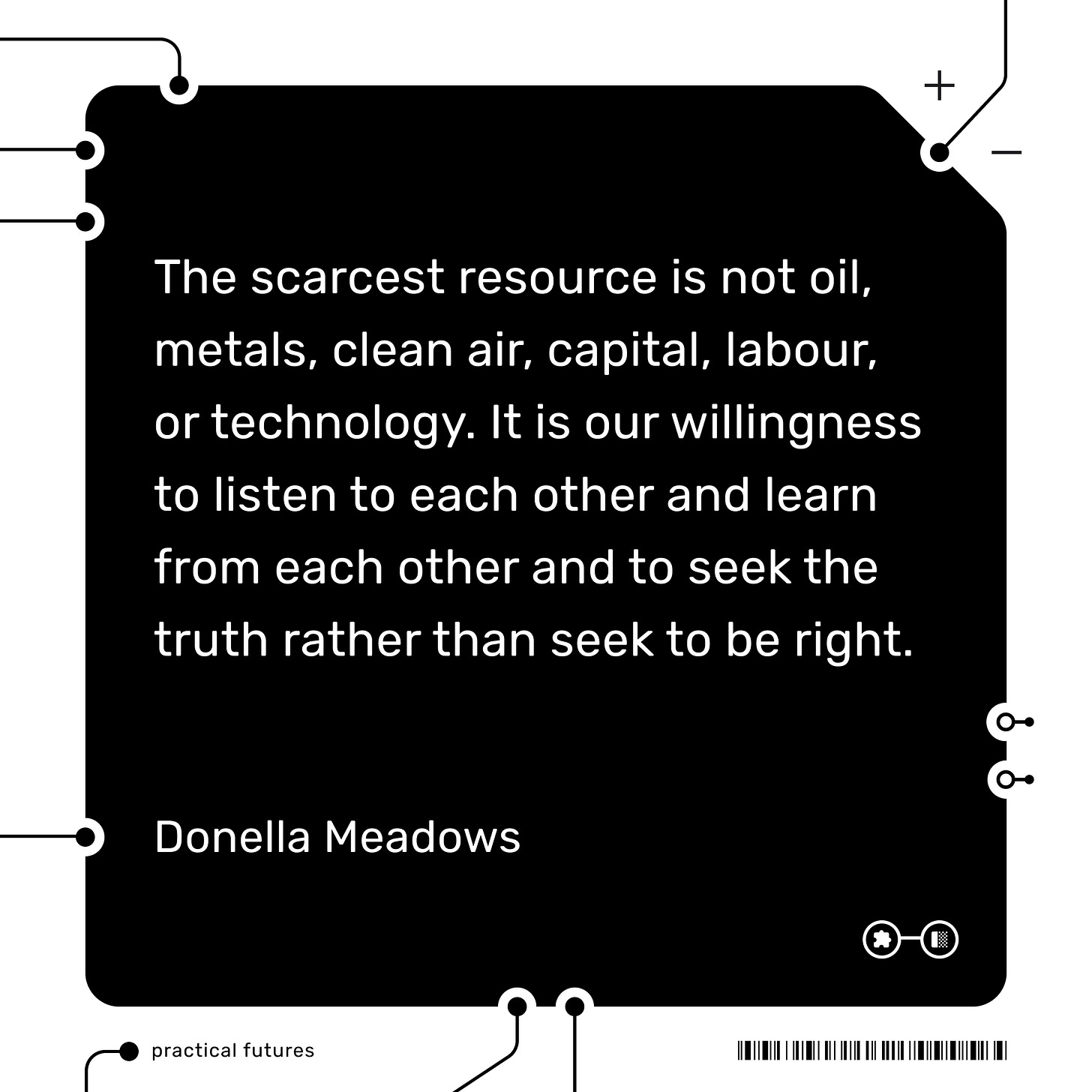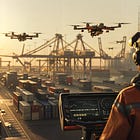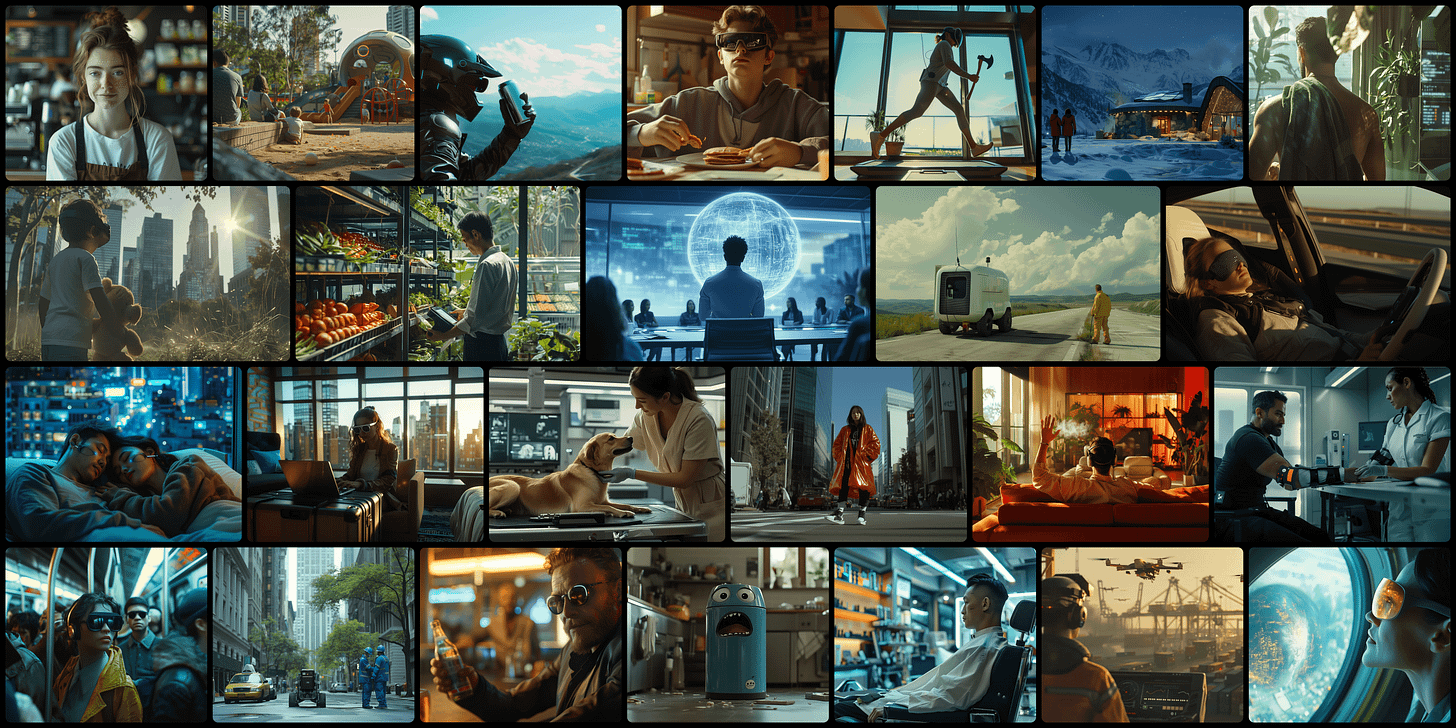- And with that, dear friends…
The presenter pauses dramatically, glancing around the auditorium for added effect.
- We can reschedule rush hours. Do I see a raised hand?
He takes a sip of water while a person in a checkered jumper stands up in the middle of the audience.
- Hi. Thanks for sharing this. I wanted to ask: what does AI know about comfortable living that makes you convinced it works with the public interest in mind?
- Thank you for this question. The answer is simple: it doesn’t. You see, mathematically speaking, the safest and most efficient mass transit system is the one without any passengers, and the most efficient road network is the one with no vehicles.
A gasp of surprise echoes in the audience, silenced by the presenter continuing.
- We have conference interpreters at the back of the auditorium today. Ask yourself why? Why use interpreters if AI could translate my whole speech much cheaper? Because translating a complete thing is an entirely different problem from doing it live.
The presenter turns to face the other part of the audience.
- To do it live, you must understand thousands of micro factors, human emotions, cultural norms, domain knowledge, body language, and how our world generally works. We don't know how to teach all these to a machine efficiently, at least not at the moment.
The presenter sighs expertly and continues.
- The problem with world modelling is that being able to do something in a controlled environment is different from doing the same thing repeatedly in changing contexts. This is why we tested combinations of different strategies instead of implementing them one by one.
He starts walking the stage.
- Together, those strategies reconceptualised rush hour from an inevitable part of living in a big city to a solvable mismatch between fixed city layouts and dynamic mobility needs. Ok, I see another question.
A woman in a grey costume asks.
- Hi, great content. My question is simple. What about cars?
- The same dynamic that makes building impossibly high structures financially feasible turns large-scale individual transport into a significant growth blocker to cities’ livability.
He spreads his arms widely with a smile.
- But hey, now I’m the only obstacle standing between all of you and lunch, and I’m not brave enough to do it for long. Let’s quickly recap how temporal decentralisation has worked for us.
Summary slides with charts and graphs packed with supporting data flicker on the auditorium screens.
- First things first. The core of this transformation is Transit Star. A single mobility-as-a-service subscription combining mass transit and residents’ road and parking access with ride-sharing and micro-mobility providers. So, the city can recommend and monitor seamless multimodal journeys.
Slide changes.
- This single subscription has a built-in credit-based mechanism where time- or comfort-sensitive users can bid for premium services using non-monetary points. Those points can’t be bought or sold and are only earned by participating in the system. Some routes or services require spending points, and others earn you points.
His hands follow his thoughts.
- Why bother collecting points? Points are spent on tradable premium services like quiet cars, guaranteed seating or parking, and access to express lanes and services.
Another slide appears on the screen showing a train, prompting the crowd's reaction.
- But the biggest hit among participants is the access to special services and collaborations with the city partners. Here, you can see a service demonstrating our commitment to supporting pollinators.
The auditorium fills with whispers.
- And before you ask. Unlike traditional congestion pricing, this model eliminates financial barriers by partially redistributing credits daily. Moreover, Transit Star relies on differential privacy without collecting personal data, solving privacy concerns that plague conventional smart-city initiatives.
Slide changes.
- Next is temporal zoning and office dispersion. Large companies are incentivised to rent “micro-offices” in multiple neighbourhoods, allowing employees to work at a near-home hub on assigned days, drastically reducing long or cross-town commutes.
Another slide, this time with a map.
- Some city zones are marked as “morning economy,” some as “afternoon economy,” and others as “night economy,” with neighbourhood-specific business hours. In return, organisations that consistently maintain off-peak schedules enjoy tax breaks, utility discounts, access to syndicated data, compute credits, and transit point subsidies for commuting employees.
The next slide shows a row of school buses.
- All our parents appreciate the district-run mini-buses that accommodate different school start times based on age groups and neighbourhoods. Of course, you may be wondering who pays for all those bells and whistles.
He pauses strategically before switching the slide to another chart.
- As you can see on this chart, the system finances itself in multiple ways. Still, the primary revenue drivers are aggregation fees from private operators, value capture taxing, and data syndication.
The chart switches to a more detailed breakdown.
- Let’s focus on those two. Value capture taxing directly ties transit-generated economic value to our revenue streams, focusing on businesses benefiting from transit infrastructure.
The chart animates onto a map with a network graph.
- On the other hand, data syndication turns anonymised data into foot traffic forecasts, neighbourhood demand trends, commuter heat maps, and service coverage maps that our partners highly value.
The slide transitions to an animated flow chart.
- All this wouldn’t be possible without our AI dispatcher. An algorithm supporting the city-level orchestration where individual travel times are managed, much like air traffic control manages flight schedules.
The presenter joins palms, signalling an upcoming conclusion.
- Our city proves AI can help cities evolve from centralised monoliths to networked ecosystems. With these strategies, the "rush hour" can become another archaic concept, giving way to a demand-responsive urban rhythm. These strategies help shift the fundamental patterns of when and where people move rather than just building more roads and lines or raising prices during peak times.
He walks to the edge of the stage.
- I’m not saying it will all be dancing and singing, but you can try figuring it out yourself. All our tools are open-source. So, feed our models with your datasets and see how and if our solutions could work elsewhere. Together, let’s make congestion a relic of the past.
The audience erupts in applause as the presenter steps offstage while the conference host takes over.
- My brain is getting fried with inspiration, and I can’t wait to play with those fancy tools. If you still have questions for our guests, don’t worry.
An animation morphing speakers into a single persona plays on the screens.
- We trained a conference avatar using all the presentations, supporting data, and all our speakers’ books so you can ask all the questions you still have after the conference.
All the screens in the auditorium switch to the agenda and a timer.
- We will now take a lunch break. The weather is taking improv classes today, so we moved our catering zone indoors. Thanks to our sponsors, the lunch area supports gravity networking. Your badges may vibrate when someone you should meet is close to you. Make the best use of it and enjoy your meal. See you at two!
Soft music fills the room. A countdown timer starts, marking the time left for the hungry crowd slowly emptying the auditorium to enjoy lunch, networking or the best of both worlds.
Hello Practical Futurists,
Welcome back from the future where transit systems are a service, not a struggle, and AI dispatchers orchestrate the millions on the move.
This is Practical Futures, where we help professionals build a future-ready mindset for the age of AI not through vague trends or speculative stats but through relatable products and services we might be using in the next few years.
Hit the "Like" button at the top or bottom of this page to help other change-makers build a future-ready mindset.Great leaders practice experiencing the future, not just thinking about it.
Like athletes visualising their performance, they build vivid mental pictures of tomorrow to make better decisions today.
Our weekly workouts use futures thinking and practical sci-fi to help you create a library of future memories - turning abstract possibilities into reference points that can inform your choices.
To spark your imagination, here's a thought to start with:
Let's make this future personal.
We'll start by connecting this story to your life, transforming abstract possibilities into memories you can use to navigate tomorrow's challenges.
Personal life reflection prompts
1. What 3 premium services would motivate you to change your commute patterns? What experiences would you save points for?2. Picture having a mobility credit profile that tracks and rewards your travel choices: - Which travel habits would you be willing to change for premium benefits? - How would you balance convenience against point-earning opportunities? - What would your ideal reward redemption strategy look like?
3. How would accessing a "near-home" office hub impact your work-life balance and community connections?4. Imagine how would your daily routine change if your neighbourhood operated on a specific (morning/afternoon/night) economy: - How would you reorganise your daily routines around the new rhythm? - What new social patterns would emerge in your community? - How would your relationship with time change?
5. What 2 benefits could convince you to permanently shift your daily schedule to off-peak hours?Nice work!
Your future memory library now has some valuable personal references. Let's fire up your thinking to add some professional leadership moments.
How will you help others navigate this future? It's time to create those memories.
Professional life reflection prompts
1. What 2 incentives would convince your company to distribute operations across multiple neighbourhood hubs?2. Imagine leading real-time operations optimization: - How did you handle conflicting optimization goals? - What feedback loops did you monitor most closely? - How did you measure optimisation success?
3. How might access to anonymised urban mobility data create new opportunities or improve decision-making in your industry?4. Imagine leading the program leveraging urban mobility data for business planning: - What insights were most valuable for your industry? - How did you use predictive models for planning? - What insights justified infrastructure investments? - How did you integrate mobility patterns into strategic decisions? - What new services have you developed based on mobility data?
5. What value could your organization create from participating in a city's mobility credit system?6. How could understanding urban mobility patterns help optimise your company's location strategy or service delivery?You did amazing! Excellent work!
Today's memories are added to your growing library of future experiences.
Thank you for expanding your imagination with us. Leaders with bold ideas move our world forward.
Think bright, and see you soon.
Pawel Halicki
Looking for something more Valentine's Day-themed?
Try this story exploring how emerging tech creates new dimensions of compromise in modern relationships.
Do you want stories like this in your inbox?
Join strategic imagination workouts that inspire change-makers in market-leading organisations, including Visa, Deloitte, Barclays, UEFA, Nielsen, Morgan Stanley, and many more.


